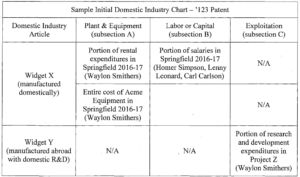In a recent Order setting the procedural schedule for a 100-Day Pilot Program proceeding, Judge Lord provided a helpful outline for proofs necessary to establish the economic prong of domestic industry. Certain Solid State Storage drives, Stacked Electronics Components, and Products Containing Same, Inv. No. 337-TA-1097, Order No. 3.
On December 21, 2017, BiTMICRO, LLC filed a complaint alleging a violation of Section 337 based on the importation of solid state storage drives by various respondents that allegedly infringe U.S. Patent Nos. 7,826,243; 6,529,416; 9,135,190; and 8,093,103. In response, certain respondents requested that the ITC utilize its 100-Day Pilot Program for dispositive issues to determine if BiTMICRO satisfies the domestic industry requirement. On January 19, 2018, the Commission instituted the investigation and, pursuant to the Pilot Program, to "hold an early evidentiary hearing, find facts, and issue an early decision, as to whether the complainant has satisfied the economic prong of the domestic industry requirement."
In accordance with the Commission's instructions, Judge Lord issued an order setting the procedural schedule for expedited proceedings to determine whether BiTMICRO satisfied the economic prong of domestic industry. In that order, Judge Lord required the complainant to provide particular domestic industry contentions in a statement and summary chart format that provides some insight into how she prefers such information be organized. The order states:
Complainant shall file a statement and chart of its domestic industry contentions identifying:
- Each of the "articles protected by the patent" that Complainant intends to rely upon as part of its asserted domestic industry, including an identification of which patent(s) correspond to each article, and a statement of whether the article is produced domestically or whether there are foreign activities related to the article.
- For each identified article, a description of each expenditure
that Complainant intends to rely upon as part of its asserted
domestic industry relating to that article, classifying each
expenditure under either subsection (A), subsection (B), or
subsection (C) of section 337(a)(3), and providing:
- A description of the expenditure, including the type of expenditure, the location and timeframe, and the identity of individuals having knowledge relevant to the expenditure;
- If an expenditure is asserted under subsection (A) or (B) of section 337(a)(3), whether all of the investment or employment is with respect to the relevant article or whether an apportionment is necessary; and
- If an expenditure is asserted under subsection (C) of section 337(a)(3), whether all of the investment is attributable to the exploitation of the asserted patent or whether an apportionment is necessary.
ALJ Lord's sample chart format (reproduced below) provides a good method to organize domestic expenditures for products protected by the asserted patents, as well as some insight into her affinity for 'The Simpsons':

Takeaway
The contention format provided by ALJ Lord provides a good guidepost for complainants to organize their domestic industry case. As we have previously posted, an ITC complainant should strive to collect data and organize arguments concerning domestic industry before filing the complaint.
The content of this article is intended to provide a general guide to the subject matter. Specialist advice should be sought about your specific circumstances.

